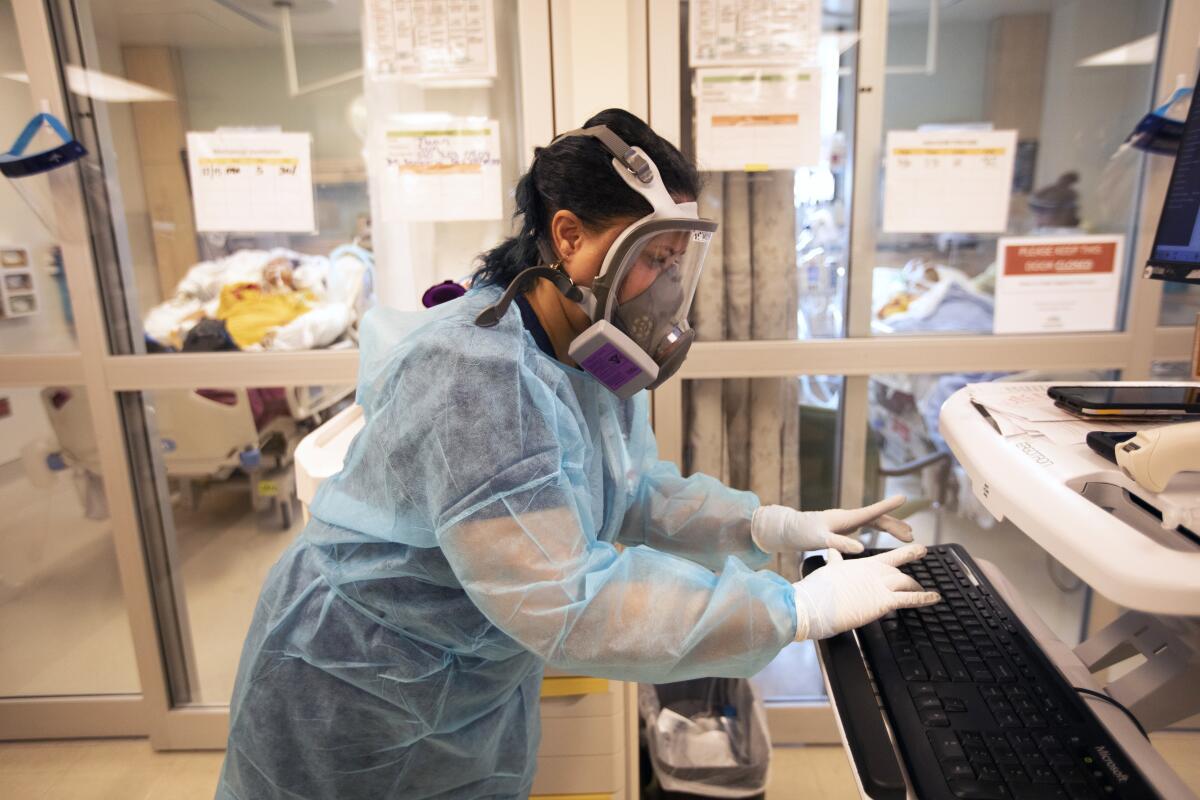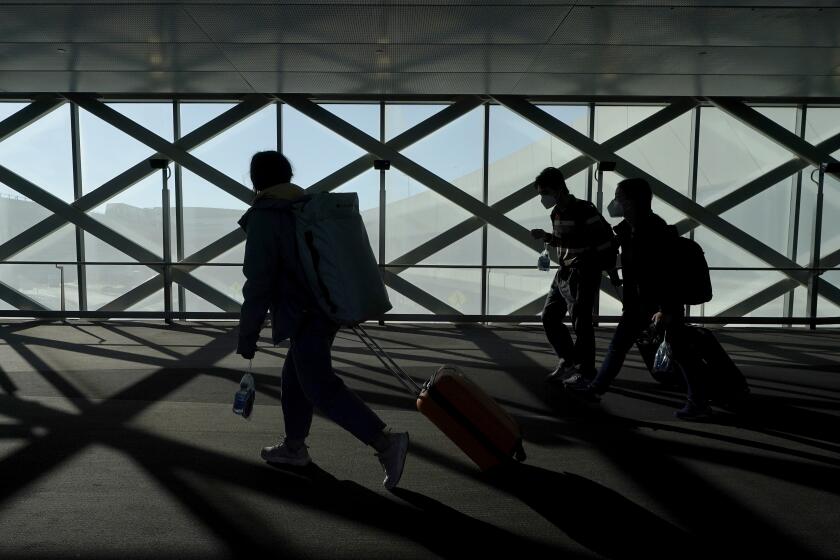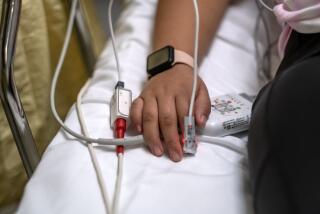L.A. County hospitals running dangerously low on oxygen, supplies as ER units are overwhelmed

- Share via
Christmas arrived in Los Angeles County with hospitals in a full-blown coronavirus crisis.
There are now so many patients that some hospitals are running dangerously low on oxygen and other supplies critical to treating those with COVID-19.
Patients are waiting as many as eight hours in ambulances before they can enter the emergency room. With intensive care units at 0% available capacity, health officials are urging that people avoid emergency rooms or dialing 911 for assistance unless absolutely necessary.
And in a grim reminder that the worst is still likely to come, one L.A. County health official has asked providers to reach out to patients who have serious illnesses or are medically frail to review their advanced-care directives and ensure forms are on file detailing their end-of-life care.
As dire as the conditions are now, there’s growing concern that large numbers of people may opt to once again ignore health guidance and gather with other households to celebrate the holidays — a potentially disastrous outcome experts say would all but certainly trigger another coronavirus surge that would further hammer hospitals already reeling from the Thanksgiving-fueled wave.
The stakes are already high, and the toll already devastating. On Thursday, L.A. County saw its most-ever COVID-19 deaths in a single day: 140.
As the coronavirus continues to spread widely and send unprecedented numbers of Angelenos to the hospital, hospitals in L.A. County are running dangerously low on their supplies of oxygen, a person familiar with the matter told The Times.
Oxygen is critical to treating severely ill COVID-19 patients who have begun to suffocate on account of their virus-inflamed lungs. Doctors and nurses have learned since the early days of the pandemic to, as much as possible, avoid placing patients on ventilators, which involves sticking a breathing tube down the throat.
Many patients instead receive a high-flow oxygen treatment, where oxygen is sent through plastic tubes placed in the nose.
And the need for that assistance is high. While a non-COVID patient may receive six liters of oxygen per minute, COVID-19 patients need 60 to 80 liters a minute.
So now, hospitals need 10 times more oxygen than they did before. There have been periods of time where hospitals have run dangerously low on their stores of oxygen before obtaining additional supplies, said the source, who spoke on the condition of anonymity.
Hospitals are also running short of other key supplies, such as the special plastic tubes used to bring the oxygen into the lungs.
The county this week sent a letter to healthcare providers urging them to take additional measures to deal with the flood of patients requiring hospital-level treatment.
“Hospitals have implemented their surge plans and are adjusting staffing and space to try to meet the needs of their community,” Dr. Sharon Balter, the county’s chief of communicable disease control and prevention, wrote in the memo. “It is critical that as a healthcare community we look at all available opportunities to help decrease the surge on hospitals and our 911 system, where possible.”
Balter asked providers to talk to patients with ongoing medical problems about when it was appropriate to visit the ER or call 911, and to do so only when it is a true emergency. She also encouraged the quick discharge of hospitalized patients to try to create as much space as possible on wards, citing a “steep increase” in COVID-19 cases and hospitalizations.
“There are very limited hospital and ICU beds available and emergency departments are strained to capacity,” Balter wrote.
There were about 6,700 coronavirus-positive patients hospitalized countywide on Wednesday, according to the latest state data, with 1,329 of them in the ICU. Those numbers have spiked by 85% and 62%, respectively, over the past two weeks.
Dr. Brian Gantwerker, a neurosurgeon in Santa Monica, said he dreaded what the next several weeks would hold. Already, the community hospital where he works is “swamped by COVID cases,” with physicians fearing they will soon have to ration care due to shortages of beds and staff.
Each day that the number of COVID-19 patients grows also increases the likelihood that more neurosurgery patients may have to wait for care or find it elsewhere, he said.
This puts doctors in the uncomfortable position of determining who receives the limited resources remaining at the hospital. A large brain tumor would probably be operated on immediately, he said, but surgery for a smaller, less dangerous one might be delayed.
“Then it becomes a question of: ‘Where is the breaking point? When do we have to start sending patients out to other places?’ And the nightmare scenario is: ‘What happens if there are no beds available in the county?’” he said. “Everything we’ve worried about and talked about and warned people about since February is coming to fruition — we’re at that point now.”
As hospitals struggle, officials are hoping people take to heart their urging to avoid gatherings and parties on Christmas Day. Should large numbers of people flout that guidance and gather with those they don’t live with over the coming winter holidays, officials and experts alike warn that will likely lead to a “surge on top of a surge” — meaning more people will become infected, fall ill and, eventually, die.
Although San Francisco and Santa Clara counties have some of the strictest travel orders in the nation, they’re not being enforced or widely publicized.
Dr. Christina Ghaly, L.A. County’s health services director, forecast this week that nearly 7,000 more people might die from COVID-19 by the end of January if current trends continue. Already, the disease has killed 9,305 people countywide.
“We know that this emergency is our darkest day, maybe the darkest day in our city’s history,” L.A. Mayor Eric Garcetti said. “But we must find the fortitude, we must summon the strength to make sure that we save lives.”
L.A. County Public Health Director Barbara Ferrer has said that crowded shopping malls are a big concern. Under the state’s regional stay-at-home orders, shopping malls are supposed to be capped at 20% of capacity, but it’s clear that those limits are not being followed.
“We’re going to take a hard look this weekend at the shopping malls because the pictures we’ve been seeing are … another little mini disaster,” Ferrer said. “The occupancy is supposed to be down to 20%. But when you look around, they look way more crowded than 20%. And that just means a complete breakdown of what we are requiring.”
Inspectors will be out over the post-Christmas weekend, Ferrer said, “and we’re going to have to take a hard look at what we see.”
She added: “The only way that those malls conceivably could be opened is because there wasn’t going to be any crowding. So if there’s a lot of crowding, that’s a situation that we have to actually get fixed right away. That can get fixed by shopping malls taking more responsibility, or that can get fixed … by us going ahead and looking at whether we need to change [health] orders. But I think the right place to start is to go and take a hard look at what’s going on.”
Latinos in California are reuniting with their loved ones in Mexico and Central America at the holidays despite dangers posed by COVID-19.
The county Department of Public Health also issued a plea Thursday for people of faith to forgo gathering indoors to worship any winter holidays, and instead attend remotely streamed or outdoor services.
Though county health officials lifted a ban on indoor religious services last Saturday — following a series of court rulings involving houses of worship that argued pandemic-related restrictions violated religious freedoms — they said in their statement that attending services indoors is “too risky” right now.
Times staff writers Jaclyn Cosgrove and Hayley Smith contributed to this report.
More to Read
Sign up for Essential California
The most important California stories and recommendations in your inbox every morning.
You may occasionally receive promotional content from the Los Angeles Times.














